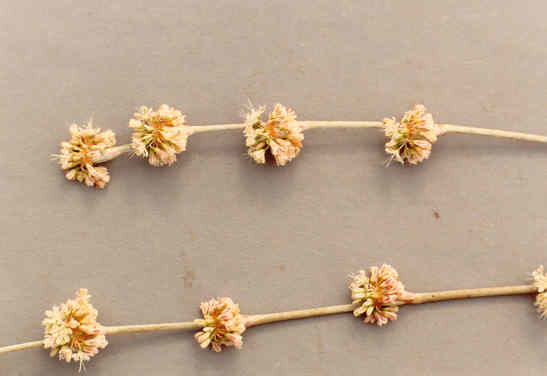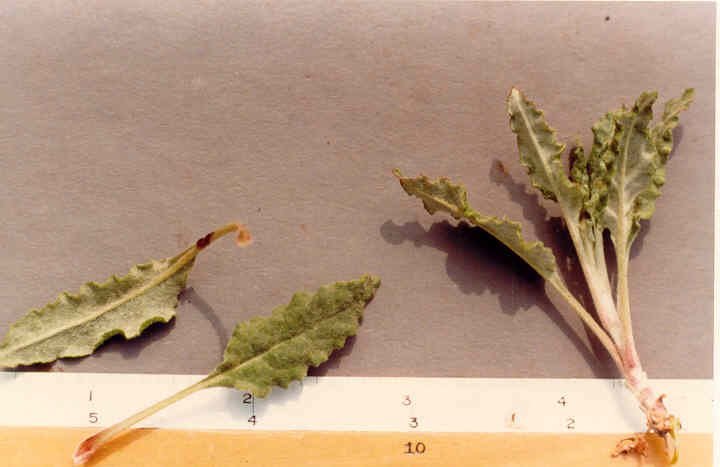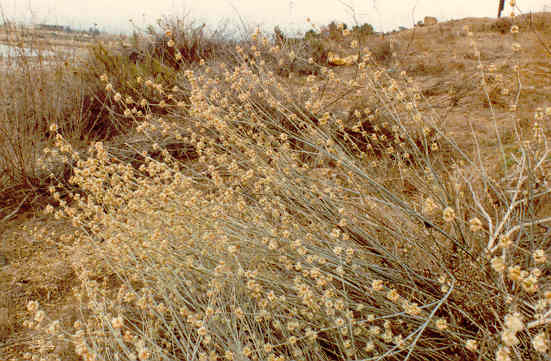
Eriogonum elongatum Benth. var. elongatum
 |
Eriogonum elongatum Benth. var. elongatum
Polygonaceae (Buckwheat Family)NativeLong-Stemmed Buckwheat |
August Photo
Plant Characteristics:
Perennial herbs, usually loosely branched at base, whitish-tomentose
nearly throughout, leafy in lower portion, passing into elongate leafless
paniculately forked infls. above, 6-12 (-18) dm. high; lvs. lance-oblong to
narrowly ovate, crisped-undulate, somewhat glabrate above, white-tomentose
beneath, 3-5 cm. long, cuneate at base, short-petioled; invols. remotely
scattered, oblong-cylindric, 6-7 mm. long, tomentose, truncate, obscurely
5-toothed; calyx white or pinkish, glabrous, 2.5-3 mm. long, the segms. obovate,
the inner slightly longer than the outer, somewhat pubescent within; fils.
glabrous; aks. dark, narrow, 2-2.5 mm. long, glabrous, somewhat 3-angled.
Habitat:
Dry rocky places below 6000 ft.; Coastal Sage Scrub, Chaparral, etc.; n.
L. Calif. to Monterey Co. Aug.-Nov.
Name:
Eriogonum is from two Greek words erion, wool and gonu, joint
or knee the type of the genus is E.
tomentosum (Munz, Flora So. Calif. 677).
Latin, elongatus, removed. (Jaeger
294). The genus name means hairy at
the nodes and the species name probably refers to the interrupted flower spike.
General:
Uncommon in the study area but fairly common on the bench below Eastbluff
and photographed there. (my comments).
Almost all of our information about using the many species of Wild
Buckwheat comes from Native American and Mexican uses.
The tea is a good and reliable eyewash, and many of the California
Indians use the tea for washing newborns. The
flowers are especially diuretic. The
tea is also useful for premenstrual water retention and fluid retention that
often occurs in the last month or two of pregnancy.
The Cahuillas, Indians of the Colorado Desert, the
San Jacinto and San Bernardino Mountains, use the tea for dull nagging
pain in pregnancy, especially in the back and hips. These are homely and gentle plants, with mild, well-defined
uses and no toxicity. (Moore, Medicinal
Plants of the Desert and Canyon West 19). A North American genus of over 200
species, mostly w.; some of importance as bee-plants, others with some
horticultural possibility. (Munz, Flora
So. Calif. 677).
Other vars. in Mexico. (Hickman,
Ed. 870).
Text Ref:
Hickman, Ed. 870; Munz, Calif. Flora 348; Munz, Flora So. Calif.
684; Roberts 33.
Photo Ref:
Aug 1 84 # 16,17; Mar 2 85 # 22.
Identity: by R. De Ruff, confirmed by F. Roberts.
Computer Ref: Plant Data 254.
Have plant specimen.
Last edit 6/1/03.
 |
 |
March Photo August Photo